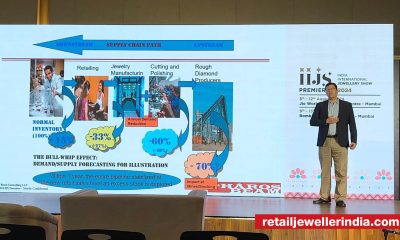IIJS
Revolutionising luxury retail experiences through AI: Highlights from IIJS Premiere 2024

In a dynamic session at IIJS Premiere 2024, industry experts explored how AI and XR technologies are reshaping luxury retail, enhancing customer interactions with groundbreaking innovations
Mumbai: At the session on ‘AI: Shaping the Future of Luxury Retail’ during the IIJS Premiere 2024 at the Jio World Convention Center, Arnav Sood, Emerging Tech Lead at Mindshare by GroupM, and Richa Singh, Managing Director, India & Middle East, Natural Diamond Council, delved into the transformative potential of AI and extended reality (XR) technologies in enhancing the customer shopping experience.
Transforming print advertising with digital layers
Sood emphasised the significant role of AI in augmenting traditional marketing avenues such as print advertising. He shared an innovative approach where digital layers are superimposed on print ads using QR codes. By scanning these codes, users could access immersive content such as 2D and 3D visuals, drastically increasing engagement time from the standard 3 seconds to an impressive 27 seconds. He illustrated this with a campaign for Britannia, which creatively linked print with digital, leveraging a cultural moment to captivate audiences.
This innovation in print is just the beginning, with Sood hinting at future developments where AI could enable holographic interactions directly from print media, allowing for a more personalised and engaging experience. This kind of integration not only captures attention but also provides measurable data on consumer engagement.
Bringing the showroom to the customer
The session also highlighted how virtual store experiences are reshaping customer interactions, especially in the context of jewellery retail. Sood discussed the use of AI and XR to create virtual walkthroughs of stores, where customers can explore and interact with products in a highly immersive environment. This was particularly useful during the COVID-19 pandemic when physical store visits were limited. Brands could send virtual invitations to their key customers, allowing them to preview and even purchase jewellery items before visiting the store.
Singh noted that consumers today are more informed and selective, often coming prepared with screenshots and links of shortlisted items. Virtual store tours cater to this behaviour by offering a tailored shopping experience, where customers can explore and select products from the comfort of their homes.

Sood also emphasised the pivotal role of generative AI in personalising customer interactions. “Generative AI allows luxury retailers to move beyond the traditional methods of customer engagement. We can now create highly personalised experiences that resonate deeply with individual customers, making each interaction unique and memorable,” he said. This technology enables brands to tailor recommendations and offers in real time, ensuring that each customer feels valued and understood.
Singh echoed these sentiments, highlighting how AI is being utilised to connect more authentically with customers. Singh explained, “AI allows us to understand our customers on a much deeper level. It is not just about selling a product; it is about creating a narrative that aligns with their values and aspirations.”

The future of AI in retail
Sood also gave a glimpse into the future, where AI and XR technologies are expected to become even more integrated into retail experiences. With advancements such as Apple and Google Glass, consumers may soon be able to have real-time, personalised conversations with AI, making informed decisions while interacting with 3D product visuals. This represents a significant leap forward in how technology will continue to shape luxury retail, especially in the jewellery industry.
The discussion also touched on the importance of data security in these advanced technologies. Sood reassured that data used in such campaigns is securely stored on company servers, with stringent measures in place to protect sensitive information, particularly in sectors like BFSI (Banking, Financial Services, and Insurance).
Challenges and solutions in haptic technology
One of the challenges discussed was the limitation of haptic technology in creating a tangible sense of touch for virtual products. While technologies like haptic gloves exist, their widespread adoption is still a challenge due to the high cost and lack of accessibility for the average consumer. However, Singh pointed out that luxury brands are already experimenting with virtual trial booths, especially in the apparel sector, where customers can see and try on products virtually before making a purchase. Although this technology is more prevalent in apparel, there is potential for its application in jewellery retail as well.
The session underscored that while these technologies might seem futuristic, they are rapidly becoming a reality, with brands already experimenting with AI and XR in various forms. The jewellery industry stands at the cusp of a digital revolution, where the fusion of traditional retail with cutting-edge technology will define the future of luxury shopping experiences.
Written by Pooja Mujumdar
Retail Jeweller India Exclusive







 Daily News2 months ago
Daily News2 months agoPC Jeweller to subdivide shares with 1:10 stock split amid record-breaking growth

 Daily News2 months ago
Daily News2 months agoKalyan Jewellers unveils limited edition ‘Pushpa’ collection ahead of Pushpa 2 release

 Daily News2 months ago
Daily News2 months agoBhima Jewellery sets Guinness World Record with ₹200 Crore Single-Day Sales on centenary celebration

 Exclusive2 months ago
Exclusive2 months agoMK Jewels’ Pink Tag Offer sparks 20 per cent sales growth across stores























